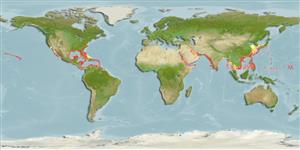Environment: milieu / climate zone / depth range / distribution range
Ökologie
seewasser riff-verbunden; tiefenbereich ? - 80 m (Ref. 5217). Subtropical; 38°N - 26°S, 99°W - 32°W
Western Atlantic: Bermuda, North Carolina (USA), and northern Gulf of Mexico to southeastern Brazil (Ref. 57756). Indo-Pacific (Ref. 26165).
Size / Gewicht / Alter
Maturity: Lm ? range ? - ? cm
Max length : 20.0 cm TL Männchen/unbestimmt; (Ref. 3790); common length : 10.0 cm TL Männchen/unbestimmt; (Ref. 3790)
Rückenflossenstacheln (insgesamt): 2; Rückenflossenweichstrahlen (insgesamt): 27-29; Afterflossenstacheln 0; Afterflossenweichstrahlen: 27 - 29. Profile from snout to origin of first dorsal spine nearly straight (Ref. 26938). No enlarged spines on caudal peduncle, but males with an elongate patch of bristle-like spinules (Ref. 13442).
More common in offshore areas, including floating seaweed and flotsam, and around islands. Juveniles are associated with floating seaweeds (Ref. 3790). Probably feeds on plants and small invertebrates (Ref. 3790). Generally considered as trash fish, rarely consumed (Ref. 3790).
Life cycle and mating behavior
Geschlechtsreife | Fortpflanzung | Ablaichen | Eier | Fecundity | Larven
Smith-Vaniz, W.F., B.B. Collette and B.E. Luckhurst, 1999. Fishes of Bermuda: history, zoogeography, annotated checklist, and identification keys. American Society of Ichthyologists and Herpetologists Special Publication No. 4. 424 p. (Ref. 35505)
IUCN Rote Liste Status (Ref. 130435)
Bedrohung für Menschen
Reports of ciguatera poisoning (Ref. 30911)
Nutzung durch Menschen
Fischereien: kleinfischerei
Mehr Information
NamenSynonymeMetabolismusRäuberÖkotoxikologieFortpflanzungGeschlechtsreifeAblaichenSpawning aggregationFecundityEierEientwicklung
ReferenzenAquakulturAquakultur ProfilZuchtlinienGenetikElectrophoresesVererbbarkeitKrankheitenVerarbeitungNutrientsMass conversion
PartnerBilderStamps, Coins Misc.LauteCiguateraGeschwindigkeitSchwimmstilKiemenoberflächeOtolithsGehirngrößeSehfähigkeit
Tools
Zusatzinformationen
Download XML
Internet Quellen
Estimates based on models
Preferred temperature (Ref.
123201): 22.7 - 28.5, mean 26.1 °C (based on 652 cells).
Phylogenetic diversity index (Ref.
82804): PD
50 = 0.5312 [Uniqueness, from 0.5 = low to 2.0 = high].
Bayesian length-weight: a=0.01549 (0.00893 - 0.02686), b=2.92 (2.77 - 3.07), in cm total length, based on LWR estimates for this species & (Sub)family-body (Ref.
93245).
Trophic level (Ref.
69278): 2.9 ±0.34 se; based on food items.
Widerstandsfähigkeit (Ref.
120179): hoch, Verdopplung der Population dauert weniger als 15 Monate. (Preliminary K or Fecundity.).
Fishing Vulnerability (Ref.
59153): Low vulnerability (10 of 100).
Nutrients (Ref.
124155): Calcium = 34.1 [13.7, 118.3] mg/100g; Iron = 0.698 [0.316, 1.765] mg/100g; Protein = 18.7 [16.4, 20.9] %; Omega3 = 0.175 [0.079, 0.351] g/100g; Selenium = 16.8 [7.0, 40.0] μg/100g; VitaminA = 39.7 [9.5, 173.6] μg/100g; Zinc = 0.898 [0.546, 1.525] mg/100g (wet weight);
